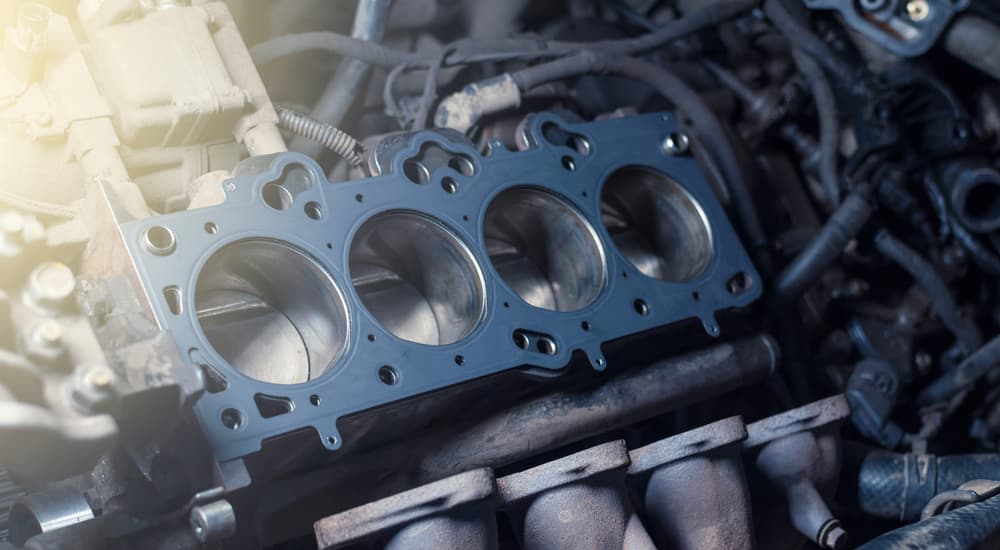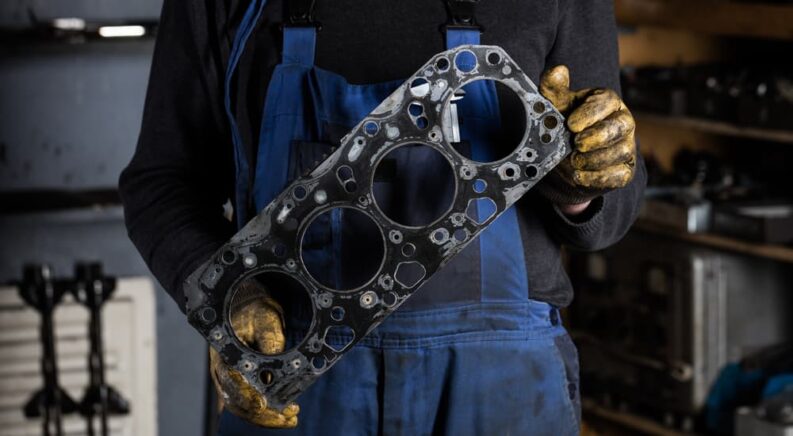For such a small part, the head gasket plays a significant role in how your engine performs. When a head gasket is working as it should, so will your engine; if it goes bad, a failed head gasket can lead to major repairs—especially if it’s not addressed right away.
Knowing what a head gasket is will give you a leg up on other drivers. Just as crucially, you need to know the signs of failure to look out for, as catching it early could be the difference between a relatively painless engine repair and the end of the line for your vehicle. Let’s talk about head gaskets and the role they play in an engine…
What Does a Head Gasket Do?
The head gasket is a multi-purpose seal that keeps each part of an internal combustion engine self-contained so they can function properly. It prevents oil and coolant from getting into the cylinders, mixing, or doing anything else these fluids aren’t supposed to. A head gasket also keeps air and fuel inside the combustion chamber, letting it build up the proper amount of pressure and compression so the engine produces the power it’s supposed to.
How Does a Head Gasket Work?
There are two primary sections in an engine. The cylinder head, which contains the valves and spark plugs, among other parts, is where the air-fuel combustion process occurs. The engine block, meanwhile, houses the cylinders and pistons. The head gasket is placed between these sections to form the seal.
Because they’re subject to more stress than almost any other part of the engine, head gaskets are typically made using thin layers of steel. This makes them stronger than traditional rubber gaskets while maintaining flexibility for a tight seal.
How Long Does a Head Gasket Last?
A head gasket isn’t something you regularly swap out like oil and air filters. If the engine is well-designed and the vehicle is primarily driven in everyday conditions, a head gasket can last a long time. Some estimates have put their normal lifespan as high as 200,000 miles.
However, the expectancy can change depending on several factors. Some engines and gaskets aren’t designed very well or are made of inferior materials; this will subject the head gasket to more stress than it can handle. A separate issue with the engine can also affect the performance and durability of the head gasket.

Why Does a Head Gasket Fail?
Assuming the engine doesn’t have a pre-existing design flaw, there are four common causes of head gasket problems. The main one is overheating, which can be due to several factors. The engine could run hot because you’re pushing it harder than it was made for, or because there’s a problem with the cooling system, or because you didn’t keep up with oil changes and other scheduled maintenance. Pushing the engine too hard when it’s cold also causes thermal stress.
Whatever the reason for it, overheating causes the other engine components to expand, which simultaneously puts even more stress on the head gasket and makes it harder to seal properly.
Pre-ignition problems can also lead to a busted head gasket. This means the air/fuel combustion mixture is igniting too early, which raises the temperature and increases the amount of pressure on the cylinder head—and thus the gasket—raising the likelihood of failure. Occasionally, a faulty head gasket is simply the result of a manufacturing effect.
Finally, bad head gaskets can happen if a rebuilt or replacement engine isn’t installed correctly. Dropping a new engine in is a challenging process, and even a small error like putting the cylinder head bolts on too tight can over-stress the head gasket and cause failure.
What Are the Signs of a Failed Head Gasket?
Because of the gasket’s importance, you should always be on the lookout for potential issues. The following are some of the symptoms of a bad head gasket…
Oil/Coolant Leaks: When the head gasket fails, the seal is no longer effective, and oil or coolant can leak out. Needing to top off either fluid regularly when there are no other obvious signs of a leak (such as a loose hose or a radiator puncture) can point to the head gasket being the culprit.
Overheating: The loss of oil or coolant hampers the engine’s ability to cool itself off, making it run hot. (If overheating is what caused the gasket to fail in the first place, then it’s a case of compounding the issue.)
Power Loss: When the gasket is faulty, the combustion chamber can’t generate as much compression and thus won’t make as much power and torque. The lack of compression can also lead to sounds such as knocking and thudding.
White/Blue Exhaust Smoke: A blown head gasket can let coolant or oil into the combustion chamber. Coolant will burn off and become white smoke or steam as it exits the tailpipe; oil in the chamber will create blue smoke.
Oil Discoloration: Coolant can get into the oil, which creates a milky white color. Look for this near the oil filler cap or by checking the dipstick.
What Should I Do If My Head Gasket Blows?
If you suspect a head gasket problem, you should immediately take your vehicle off the road until it’s fixed. The more you drive with a bad head gasket, the more likely it is to lead to far more severe problems, such as warped cylinder heads and valves and damaged catalytic converters. In some cases, you can end up with irreparable damage.
The best course of action to fix a head gasket depends on the extent of the damage, how long you have been having problems, and how old the vehicle is. If a head gasket simply has a minor crack or perforation and you discover the problem quickly, you may be able to repair it using a head gasket sealer. This can cost anywhere from $20 to $70, depending on the product quality and the bottle size. Follow the instructions and be sure to monitor the head gasket diligently going forward.
For more severe cracks and blown head gaskets, you will need the gasket replaced. This won’t be cheap; Consumer Reports found that even if no other problems have developed, basic head gasket replacement can cost more than $2,000. The exact amount depends on the vehicle and where you get it repaired. For an engine that has suffered other harm because of the blown gasket, you could easily be looking at double the expense, whether to fix the existing engine or get a new one.
Once you get a repair estimate, you’ll have to weigh the cost of fixing the head gasket versus getting another vehicle. Generally speaking, the newer the vehicle, the more benefit there is going through with the repairs. Keep in mind, though, that if the failure was the result of an engine design flaw or a poorly constructed OEM head gasket, there’s a decent chance the problem will come up again.
Stay Ahead of Head Gasket Problems
The head gasket is something many vehicle owners don’t think about until it becomes a problem—but when it does, it’s a big headache. The best approach is to do everything in your power to prevent head gasket failure, including staying up to date on scheduled maintenance and limiting its exposure to extreme conditions. If any sort of issue does develop, whether with the head gasket or anywhere else in your powerplant, you’ll want to deal with it as soon as possible so it doesn’t lead to more severe engine repair needs.

